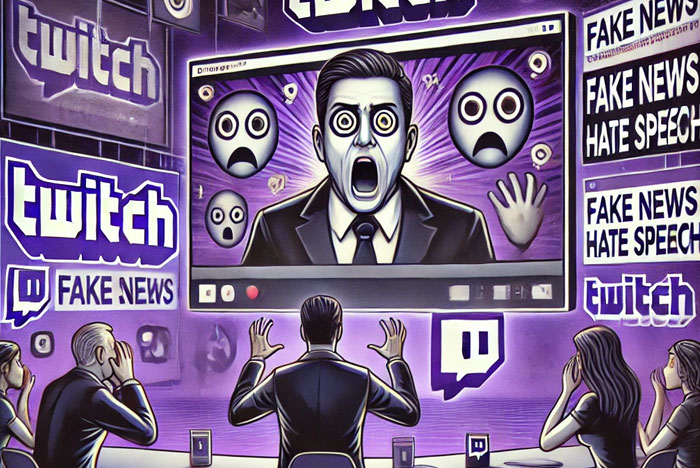🎥 Twitch’s Advertising Crisis: What Happened and What’s Next? 🎮
Twitch is facing one of its biggest challenges yet. Streamers are sounding the alarm, reporting massive drops in their ad revenue. For some, income from ads has dried up completely. The situation has been dubbed the “Adpocalypse,” and it’s creating chaos across the platform. But how did it get this bad, and what can Twitch do to fix it? Let’s take a closer look. 🧐👇
What’s the Problem?
Ad revenue on Twitch is in freefall, and streamers are frustrated. Even those with family-friendly or non-controversial streams are seeing their earnings vanish. 🕳️ This all seems tied to new “content labels” introduced by Twitch. These labels identify specific topics in streams, like politics, and automatically block ads from running on them.
On paper, this sounds like a smart idea to reassure advertisers. In practice, it’s causing headaches. Many streamers say they’ve lost revenue even though their content doesn’t fall into these flagged categories. It’s not just political streamers feeling the pinch—this policy seems to have created unintended consequences for everyone.
🎤 Devin Nash, a well-known streaming business expert, warned this might happen months ago. He predicted advertisers would pull out if their ads appeared next to controversial content. Now, it looks like his prediction has come true.
How Did Asmongold’s Ban Spark the Crisis?
The drama escalated when Twitch banned popular streamer Asmongold in October. The ban came after he commented on the Gaza conflict. This sparked a heated debate about Twitch’s handling of sensitive topics. 🛑
Critics accused Twitch of inconsistency. They pointed out that other streamers, like HasanAbi, made similar comments but weren’t banned. This fueled accusations of favoritism, creating a bigger divide in the community. Things took a turn when some individuals pressured advertisers directly, calling on them to pull their campaigns from Twitch.
According to former Twitch star Ludwig Ahgren, this backlash led advertisers to withdraw in November. He suspects Twitch didn’t have enough time to resell those ad slots, leaving streamers without ad revenue. It’s a chain reaction: advertisers pulled out, creators suffered, and Twitch is now in damage control mode. 💸
What Twitch Can Learn from YouTube
 Ludwig has some ideas for fixing the mess. Right now, Twitch’s main tool for handling controversies is banning creators. 🚫 While bans are effective in extreme cases, they’re a blunt instrument. They stop creators from producing content altogether, which harms both the streamers and Twitch itself. 🥶
Ludwig has some ideas for fixing the mess. Right now, Twitch’s main tool for handling controversies is banning creators. 🚫 While bans are effective in extreme cases, they’re a blunt instrument. They stop creators from producing content altogether, which harms both the streamers and Twitch itself. 🥶
💡 YouTube handled a similar problem better. Back in 2017, advertisers were furious when their ads appeared on videos with extremist content. Instead of banning creators outright, YouTube introduced a smarter system. Creators now self-report whether their content is advertiser-friendly. Automated systems verify their claims, and creators who lie face stricter rules.
This system strikes a balance. It protects advertisers without completely cutting off creators. Ludwig believes Twitch should follow YouTube’s lead. By removing monetization from controversial content instead of banning creators outright, Twitch can keep advertisers happy without alienating its streamers.
The Community’s Response
As you’d expect, this issue has sparked heated debates. Not everyone agrees with Ludwig’s take. Some viewers accuse him of sugarcoating the problem to protect his friends, like HasanAbi. 🧐 They argue that Twitch’s biggest political streamers played a role in the crisis and should take responsibility.
Others, however, appreciate Ludwig’s approach. They say his analysis is thoughtful and focuses on solutions rather than assigning blame. Instead of creating more drama, Ludwig is encouraging constructive change, which many find refreshing.
The discussion doesn’t stop there. Other big names in the streaming world, like Destiny, Ethan Klein, and dancantstream, have weighed in. 🔥 Each of them has their own perspective on the crisis, and tensions are running high. The community is divided, but one thing is clear: Twitch needs to act fast.
What Are the Next Steps for Twitch?
Twitch is at a turning point. This crisis could be an opportunity to evolve or a warning sign of bigger problems to come. Either way, Twitch has to make some tough decisions. The platform can’t afford to lose more trust with its creators—or its advertisers.
A system like YouTube’s could be the way forward. Letting creators self-report on their content, combined with automated checks, could help restore balance. Controversial content could still exist but without ad support, giving advertisers peace of mind. Meanwhile, bans would be reserved for extreme cases only.
Transparency is also critical. Twitch’s enforcement policies often feel inconsistent, leaving Twitch streamers confused and frustrated. By clearly communicating their rules and processes, Twitch could rebuild trust with its community.
Final Thoughts
Twitch’s advertising crisis isn’t just about money—it’s about trust. Creators feel unsupported, advertisers feel uneasy, and viewers are caught in the middle. The platform needs to find a way to balance the needs of all three groups. It won’t be easy, but it’s possible with the right changes.
What do you think? Should Twitch take more cues from YouTube? Or do they need a completely new approach? Let us know your thoughts—we’d love to hear them! 💬









